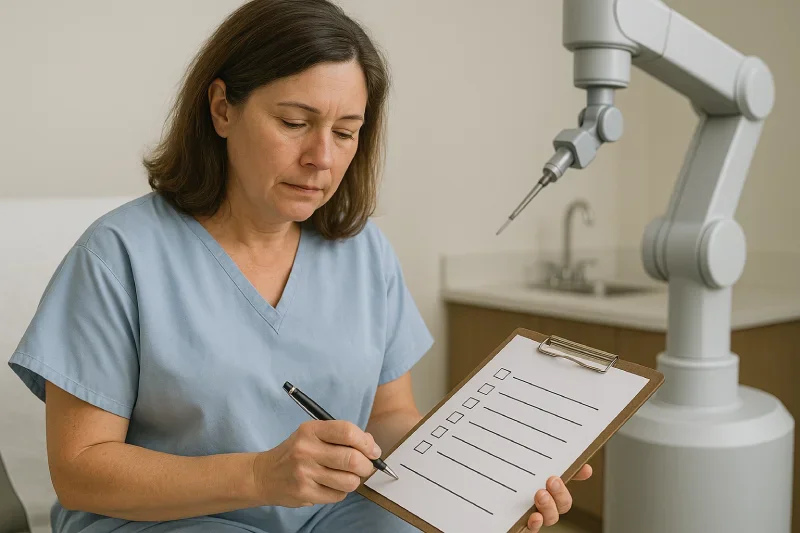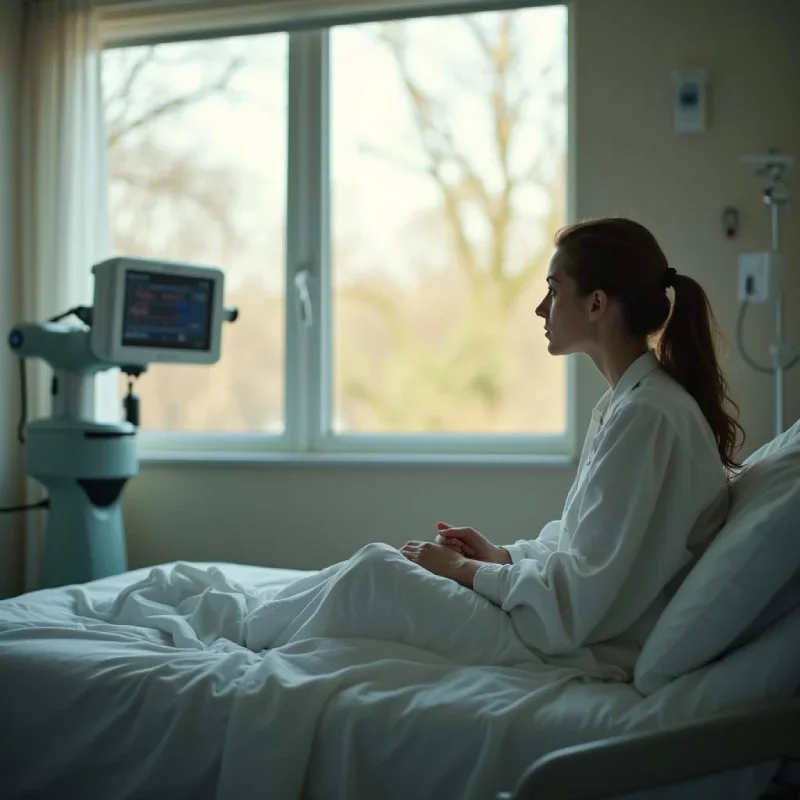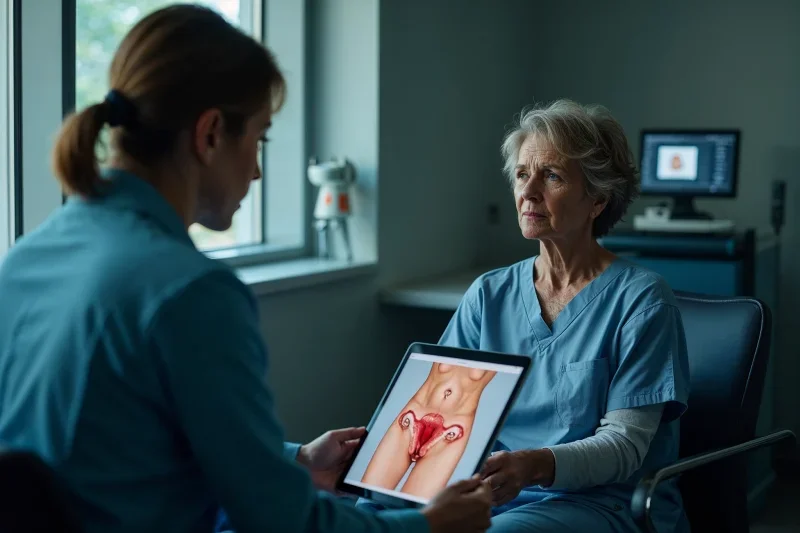Can I Get Pregnant 10 Years After Essure in Burleson, TX?
Categories:
By: Ethan Cole
Wondering whether a baby might still be in your future a full decade after your Essure sterilization in Burleson, TX? The concise answer is yes—pregnancy can and does happen even 10 years after Essure placement because no contraceptive method is 100 percent fail-proof. Although the manufacturer promoted Essure as “permanent,” real-world data, FDA reports, and firsthand patient stories have confirmed late conceptions.
If you suspect you’re pregnant or if you’re actively trying to conceive after Essure, this in-depth guide explains current scientific findings, local Essure removal and IVF resources, and the safety protocols a Burleson OB-GYN such as Dr. Jason Neef, MD will recommend today.
Key Takeaways
Pregnancy is rare but possible 10+ years after Essure. Long-term studies and patient registries confirm that scar tissue can break down, coils can migrate, or only one tube may have occluded fully.
Your individual risk varies. Coil position, prior uterine surgery, weight changes, perimenopause, and autoimmune inflammation all influence whether sperm can bypass the barrier.
Essure increases ectopic pregnancy risk. A missed period should trigger immediate at-home testing, followed by a serum β-hCG and ultrasound at a Burleson clinic.
If you wish to conceive intentionally, the two proven routes are Essure removal with tubal reversal or in-vitro fertilization (IVF) that bypasses your fallopian tubes.
Choosing a fellowship-trained Burleson or Fort Worth surgeon who specializes in Essure reversal significantly boosts success rates and limits complications such as coil fragmentation or uterine perforation.
Most insurance plans classify Essure reversal as elective, but removal for pain, heavy bleeding, or suspected device migration may be covered as “medically necessary.” Check pre-authorizations early.
Can You Get Pregnant 10 Years After Essure Removal?
Many women worry that the passage of time reduces their chances of conceiving after Essure removal. The reality is that even 10 years later, pregnancy is possible if the tubes can be reconstructed and ovarian reserve remains healthy.
Studies show that women who undergo Essure removal followed by in-vitro fertilization (IVF) often achieve success regardless of how many years have passed since device placement. For those seeking natural conception, the key factors are whether enough functional tube remains and whether egg supply is adequate.
Is Pregnancy Possible After 10 Years With Essure?
If the Essure devices are still in place after 10 years, natural pregnancy is not possible because the inserts block sperm from reaching the egg. In these cases, patients in Burleson usually pursue either device removal with IVF or tubouterine implantation, depending on their fertility goals.
Dr. Neef emphasizes thorough testing first: ovarian reserve labs, imaging to assess uterine health, and discussion of whether IVF offers a faster route to pregnancy after a decade.
Understanding Essure: Why “Permanent” Sometimes Turns Out Temporary
To grasp why late pregnancies occur, it helps to revisit how Essure works and why the FDA ultimately discontinued sales.
How Essure Blocks the Fallopian Tubes
During a 10- to 15-minute office procedure, your provider inserted tiny nickel-titanium coils into the proximal segment of each fallopian tube using a hysteroscope. Over 8–12 weeks, your body formed fibrotic scar tissue around each micro-insert, sealing the tube so sperm and eggs never meet. A follow-up confirmation test—traditionally a hysterosalpingogram (HSG)—was supposed to verify total occlusion. Unfortunately, not every patient received that post-placement imaging, and small gaps could remain undetected.
FDA History, Black-Box Warning, and Market Withdrawal
2002: Essure earned FDA approval as the first incision-free sterilization device.
2016: The FDA added a black-box warning citing chronic pelvic pain, bleeding, allergic reactions, and device migration.
2019: Bayer voluntarily halted U.S. sales; however, an estimated 750,000 Americans still have the inserts in place.
2020-2028: The FDA ordered extended post-market surveillance to track long-term outcomes, including pregnancies beyond 10 years.
Why Clinical Trial Data Didn’t Predict Real-World Failures
Tightly controlled trials reported a 99.83 percent five-year efficacy. Yet real-life variables—Cesarean deliveries, D&Cs, endometrial ablations, hormonal fluctuations, and autoimmune diseases—can remodel tubal tissue, allowing a microscopic passageway to re-open years later.
Pregnancy Odds 10 or More Years After Essure
While unintended conception remains uncommon, you deserve transparent statistics:
|
Contraceptive Method |
10-Year Pregnancy Rate |
Number of Subjects |
Study / Registry Year |
|
Essure (ideal placement) |
0.2 % – 0.6 % |
16,000+ |
Bayer Post-Market Study, 2023 |
|
Essure (suboptimal placement) |
2 % – 4 % |
4,300 |
French National Cohort, 2021 |
|
Laparoscopic tubal ligation |
1.8 % |
7,500 |
ACOG Data, 2022 |
|
No contraception |
85 % |
10,000 |
CDC, 2021 |
How Failure Rates Creep Up Over Time
Scar tissue can thin as estrogen and progesterone levels fluctuate in your late 30s and 40s.
Prior pregnancies stretch uterine tissue; postpartum remodeling may nudge coils out of position.
Abdominal or pelvic surgeries can jostle the inserts, widening the tubal lumen.
Systemic inflammation (e.g., lupus, rheumatoid arthritis) may dissolve fibrotic barriers.
High-Risk Factors for Late Pregnancy
Only one tube fully occluded (single-side closure).
Coil migration into the uterine cavity or peritoneum.
Endometrial ablation or myomectomy performed after Essure.
Rapid weight loss or bariatric surgery altering pelvic anatomy.
Failure to complete the mandatory three-month HSG confirmation.
How to Recognize a Possible Pregnancy With Essure Still In Place
Early detection is vital, especially because Essure raises the risk of ectopic implantation.
Classic but Overlooked Symptoms
Missed or unusually light period (often chalked up to perimenopause).
Breast tenderness, nausea, and unexplained fatigue.
One-sided pelvic pressure differing from menstrual cramps.
Red-Flag Signs of an Ectopic Pregnancy
Sudden knife-like lower-abdominal pain.
Shoulder tip pain indicating internal bleeding.
Dizziness, fainting, or rapid pulse.
If you experience any of these symptoms in Burleson or surrounding Johnson County, call 911 or head to the nearest emergency department immediately.
Diagnostic Steps Your Burleson OB-GYN Will Take
Serum β-hCG test 48 hours apart to track hormone doubling time.
Transvaginal ultrasound once hCG reaches 1,500 mIU/mL, usually at five to six weeks gestation.
Repeat imaging and consult with maternal-fetal medicine if coil proximity threatens the gestational sac.
Fertility-Restoring Options in Burleson, TX
If parenting another child is your goal, modern fertility care in the Dallas–Fort Worth metro—including Burleson, Crowley, and Mansfield—offers two primary paths.
1. Essure Removal and Tubal Reversal Surgery
Performed via laparoscopic, mini-laparotomy, or robotic techniques.
The surgeon excises the coils plus adjacent scar tissue, then re-anastomoses healthy tubal segments.
Success rates vary by age and tubal length—women under 35 may see 60–70 percent live-birth rates, whereas women over 40 average 30–35 percent.
Pros:
– Enables natural conception month after month.
– Lower lifetime cost than multiple IVF cycles for many couples.
Cons:
– Requires general anesthesia and one- to three-week recovery.
– Not feasible if too little healthy tube remains after coil removal.
Cost in Burleson: $6,500 – $9,000 self-pay; some medical-necessity cases obtain partial insurance coverage.
2. In-Vitro Fertilization (IVF) Without Removing Essure
Ovaries are stimulated; eggs are retrieved, fertilized in the lab, and embryos placed directly in the uterus.
The coils generally remain in situ unless they protrude into the uterine cavity.
Pros:
– No abdominal surgery or coil extraction required.
– Predictable success per cycle; combined rates often surpass 50 percent for women under 38.
Cons:
– Upfront cost of $12,000–$18,000 per cycle in North Texas.
– Long-term medication side effects (e.g., bloating, mood swings).
– Multiple gestation risk if transferring more than one embryo.
Comparing Cost, Time, and Success
Essure reversal may be more economical for younger women expecting more than one child. IVF may be preferable if you are older, have significant male-factor infertility, or if your tubes are too short for re-anastomosis. Many Burleson couples finance treatment through CareCredit, bundle-pricing at Fort Worth Fertility, or employer fertility benefits at companies like Alcon and Lockheed Martin.
Choosing a Qualified Essure Specialist Near Burleson
Selecting the right surgeon or fertility center is arguably the most critical step.
Questions to Ask at Your Consultation
“How many Essure removals or reversals have you completed in the past 12 months?”
“What is your live-birth rate for my age group?”
“Will you perform an HSG or saline sonogram three months after surgery?”
“Do you provide on-site pathology to confirm complete coil extraction?”
“What is your complication rate for uterine or tubal perforation?”
Trusted Regional Providers
Dr. Jason Neef, MD – Board-certified OB-GYN serving Burleson, Joshua, and Crowley; offers hysteroscopic and laparoscopic Essure removal.
Fort Worth Fertility – Combines reproductive endocrinology, IVF labs, and microsurgical tubal reversal services.
Texas Health Huguley Hospital Fort Worth South – Minimally invasive gynecologic surgeons with robotic proficiency.
Safety Concerns if Pregnancy Occurs Before Removal
Women who conceive with Essure still in place require high-risk obstetric surveillance.
Ectopic monitoring: Serial β-hCG and weekly ultrasounds until intrauterine location is confirmed.
Coil-fetal proximity checks: Repeated imaging ensures the device is not eroding into the gestational sac.
Delivery planning: If coils are partially intramural, your obstetrician may recommend a planned Cesarean to avoid coil dislodgement during labor.
Conclusion
Although Essure was marketed as a lifelong contraceptive, pregnancy a decade later is scientifically documented and clinically manageable. Whether you’ve noticed early pregnancy signs or you’re dreaming of expanding your family in Burleson, act swiftly: confirm pregnancy status, rule out ectopic risk, and consult an Essure-savvy OB-GYN such as Dr. Jason Neef. For intentional conception, Essure removal with tubal reversal or IVF are both viable routes.
By partnering with an experienced local specialist, reviewing success statistics, and arranging financing early, you can maximize both safety and your chance of welcoming a healthy baby.
Schedule a personalized Essure consult with Dr. Neef today.
Call (817) 568-8731Categories:
Frequently Asked Questions
-
Most modern MRI machines are compatible with Essure’s nickel-titanium alloy, but artifact shadows can obscure pelvic images. Always tell your radiology tech you have Essure so they can adjust sequences or opt for CT if needed.
-
Many women report reduced joint pain, fatigue, and rashes after extraction, although studies remain inconclusive. Symptom improvement may result from eliminating chronic inflammatory stimulus around the coils.
-
Yes. Even with patent tubes, a severe male-factor issue could lower natural conception odds. A semen analysis before deciding between reversal and IVF can save time and money.
-
Most surgeons use general anesthesia with endotracheal intubation for laparoscopy or mini-laparotomy. Some offer spinal or epidural blocks for mini-lap procedures lasting under 90 minutes.
-
Patients with desk jobs often resume work in 5–7 days; those with physically demanding roles may need two weeks. Robotic or mini-lap techniques generally shorten downtime compared with open surgery.
-
Typically, bleeding becomes lighter or returns to your pre-Essure pattern once the device and associated inflammation are gone. If heavy periods persist, your OB-GYN can evaluate for fibroids or adenomyosis.
-
Most Dallas–Fort Worth fertility clinics treat women up to age 50 with their own or donor eggs, provided overall health permits pregnancy. Success rates decline sharply in the mid-40s, so early consultation is wise.
-
Most patients choose between Essure removal with reconstruction, IVF after device removal, or donor egg IVF depending on age, ovarian reserve, and tube health. A consultation with Dr. Neef helps clarify the fastest path to success.
-
Yes, some women do conceive naturally after Essure removal, even 10 years later, provided there is enough healthy tube remaining and ovarian reserve is strong. Success rates vary widely and depend on age and overall fertility health.
-
No. The Essure device is designed to permanently block the fallopian tubes, so pregnancy is not possible unless the device is removed or bypassed with IVF.













